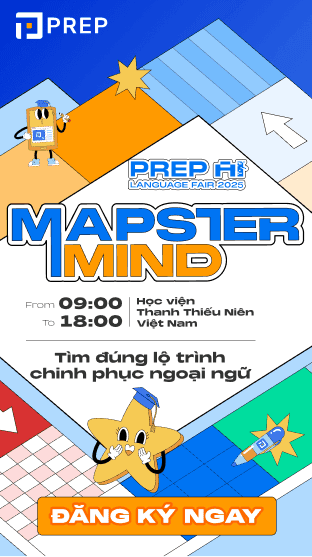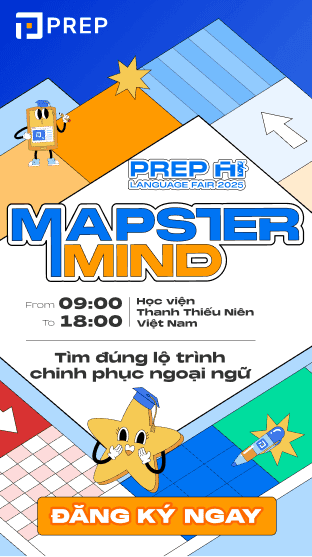Bài mẫu IELTS Speaking Part 2, 3: Talk about your favorite food
Talk about your favorite food - đề thi IELTS Speaking thuộc chủ đề Food. Bên cạnh đề bài Talk about your favorite food, bạn cũng có thể bắt gặp với các dạng cấu trúc câu hỏi khác nhau như: Describe a special meal you have had, Describe your favorite food hay Describe a place you like to eat at,...

I. Bài mẫu IELTS Speaking Part 2 chủ đề “Talk about your favorite food”
Cùng Prep tìm hiểu 1 trong những bài IELTS Speaking chủ đề " Talk about your favorite food" nhé
1. Đề bài Talk about your favorite food

2. Dàn bài
2.1. Ý tưởng bài mẫu (tiếng Việt)
|
Bối cảnh |
Miêu tả món ăn |
|
|
|
Lý do + cảm xúc |
|
|
2.2. Take note trong 1 phút (tiếng Anh)
| Settings (who, what, when, where…) | Descriptions of the dish |
|
|
|
Why + Feelings |
|
|
3. Sample Speaking chủ đề Talk about your favorite food
Cùng nghe Podcast bài mẫu IELTS Speaking Part 2 - Talk about your favorite food:
I am no food connoisseur, but there are certain dishes that I am partial to, and one of them is dimsum, which I am going to talk about today. So, as a bit of an introduction, dimsum is a traditional Chinese meal made up of dumplings - small savory balls of dough along with different snack dishes and is usually accompanied by tea. I first got introduced to this delectable meal on a trip to Hongkong 3 years ago and have become infatuated with it ever since.
To describe dimsum, it is considered a light snack, as the small portions of dimsum are not meant to satiate a person’s appetite. Dimsum is best served as brunch, from late morning till past lunch. It originates from Guangdong, China, when many merchants traveling along Silk Road would drop by tea houses to enjoy this special dish along with some tea. By now, it has gained popularity worldwide as one of the main features in Chinese cuisine. There is a wide array of dimsum dishes with ingredients ranging from seafood and meat to vegetables. These are all prepared in an assortment of methods, including steamed, fried, or baked.
Despite its diversity, there are still staple dishes that are available in most restaurants, such as: shumai, shrimp dumplings, chicken feet, or egg tarts. Dimsum are usually served in steam-heated carts or bamboo baskets. According to traditional etiquette, the type of tea that goes along with dimsum must also be chosen quite meticulously and for newbies, green tea, Oolong tea and Chrysanthemum tea are usually recommended.
I can list out literally a thousand different reasons why I fancy dimsum so much, but let’s be modest and just go through a few. First of all, I have great passion for tea, especially the oriental type, so to find dishes that complement my favorite drink is obviously stunning. What also stands out about this special food is that there is always a dimsum flavour or texture that could satisfy even the pickiest eaters in the world.
I would admit, it is not the healthiest delicacy one could find because it tends to be rich in calories. However, its special taste and the fact that it is made to be shared with many other people turn it into such an amazing choice for gatherings.
- connoisseur (n): chuyên gia ẩm thực
- to be partial to (a): thích thú
- savory (a): thơm ngon, mặn
- to be accompanied by (v): đi kèm với
- delectable (a): ngon lành
- infatuated with (a): vô cùng hứng thú, cuồng nhiệt về cái gì
- satiate someone’s appetite (phr): thỏa mãn cơn đói
- brunch (n): bữa ăn giữa bữa sáng và bữa trưa
- drop by (phrasal verb): ghé qua, rẽ qua
- gain popularity (phr): trở nên nổi tiếng
- A wide array of = an assortment of: rất nhiều
- staple dishes (phr): các món ăn tiêu biểu
- etiquette (n): phép xã giao, nghi lễ, nghi thức
- meticulously (adv): tỉ mỉ, kĩ càng
- literally (adv): theo nghĩa đen, thực sự
- fancy (v): thích
- oriental (a): thuộc về phương Đông
- texture (n): kết cấu, cấu tạo bề mặt
- picky (a): khó tính, kén cá chọn canh
Tham khảo thêm bài mẫu IELTS Speaking Part 2:
II. Câu trả lời mẫu Part 3 chủ đề: Food
Cùng nghe Podcast bài mẫu IELTS Speaking Part 3 - Topic Food:
1. What kinds of food are popular in your country?
Vietnamese culinary culture has always been renowned for its diversity, with each region expressing distinct appetite through various ingredients and cooking techniques. Therefore, it can be a bit challenging to name just a few popular dishes, as the answer may vary greatly depending on where a Vietnamese is from. However, there are some notable dishes, such as Pho, bánh mỳ and chè, which is a type of sweet dessert. These all have terrific flavour and are must-try for any visitors wanting to experience Vietnamese cuisine.
- culinary culture (n): văn hóa ẩm thực
- renowned for (a): nổi tiếng vì
- distinct (a): riêng biệt
- appetite (n): khẩu vị
- terrific flavour (n): hương vị tuyệt vời
- must-try: nhất định phải thử
2. Do you think different regions have different food?
Absolutely! Vietnam and its delicacy collection is an archetype. As Vietnam can be divided into three areas (North, Central, South) with vastly different geographical and climatic characteristics, each particular region’s distinct features are all reflected in the dishes. For example, Central Vietnam consists of mostly hills and mountains, where spices are readily available, so the food here is famous for being more spicy and incorporating more spices compared to other regions.
- delicacy collection (n): nền ẩm thực
- archetype (n): ví dụ tiêu biểu
- geographical and climatic characteristics (n): đặc điểm địa lý và khí hậu
- incorporate (v): kết hợp
3. Do you think that food plays an important part in festivals?
I can’t speak for the rest of the world, but in my country, food is an indispensable part of any festivals, big or small. Some of our festivals’ ceremonies are centered around food. Take Cold Foods festival as an example. During this time of the year, Vietnamese people would eat bánh trôi and bánh chay - traditional dishes for this eve - with the whole family.Tet holiday, another crucial festival in Vietnam, is also characterized by many special foods that are only served in the Lunar New Year, such as bánh chưng or candied fruits.
- indispensable (a): không thể thiếu được
- to be centered around (v): xoay quanh, tập trung quanh
- crucial (a): quan trọng
- candied fruits (n): mứt
4. Do you think people cook too much for celebrations? How to reduce food wastage?
As celebrations are usually time for social gatherings, it can be a norm for people to try making as much food as possible so everyone can eat to their hearts’ content. I would admit, this may sometimes lead to overestimation of people’s eating capacities. To minimize the amount of food wasted, I think people can, first of all, roughly estimate the right portions to cook. If there is surplus edible food, people can try donating it to institutions or recycling organisations, too. In this way, food wastage can be avoided and people will still be able to eat freely in these festivals.
- social gatherings (n): họp mặt cộng đồng
- norm (n): điều bình thường
- eat to their heart's’ content (idiom): ăn thoải mái
- overestimation (n): đánh giá quá cao
- eating capacities (n): sức ăn
- roughly estimate (v): ước lượng đại khái
- portions (n): khẩu phần ăn
- surplus (n): phần thừa ra
- edible (a): có thể ăn được
Trên đây là bài mẫu IELTS Speaking Part 2 + 3 chủ đề Talk about your favorite food. PREP chúc bạn học luyện thi IELTS hiệu quả và chinh phục được band điểm thật cao trong kỳ thi Speaking thực chiến!

Chào bạn! Mình là Hiền Hoàng, hiện đang đảm nhận vai trò quản trị nội dung sản phẩm tại Blog của website prepedu.com.
Với hơn 5 năm tự học các ngoại ngữ như tiếng Anh, tiếng Trung và ôn luyện một số kỳ thi IELTS, TOEIC, HSK, mình đã tự đúc rút được nhiều kinh nghiệm để hỗ trợ hàng nghìn người đang gặp khó khăn trong việc học ngoại ngữ. Hy vọng rằng những chia sẻ phía trên sẽ giúp ích cho bạn trong quá trình tự ôn luyện thi hiệu quả tại nhà!
Bình luận
Nội dung premium
Xem tất cảLộ trình cá nhân hoá
Có thể bạn quan tâm
Kết nối với Prep

MSDN: 0109817671.
Địa chỉ liên hệ: Tòa nhà Vinaconex, 34 Láng Hạ, phường Láng, TP Hà Nội.
Trung tâm CSKH tại HN: Lô 21 C2 Khu đô thị Nam Trung Yên, phường Yên Hòa, TP Hà Nội.
Trung tâm CSKH tại HCM: 288 Pasteur, Phường Xuân Hòa, TP Hồ Chí Minh
Trụ sở Công ty: Số nhà 20, ngách 234/35 đường Hoàng Quốc Việt, phường Nghĩa Đô, TP Hà Nội.
Phòng luyện ảo - Trải nghiệm thực tế - Công nghệ hàng đầu.
Hotline: 0931 42 8899.
Trụ sở Công ty: Số nhà 20, ngách 234/35 đường Hoàng Quốc Việt, phường Nghĩa Đô, TP Hà Nội.
Giấy chứng nhận hoạt động đào tạo, bồi dưỡng số 1309/QĐ-SGDĐT ngày 31 tháng 07 năm 2023 do Sở Giáo dục và Đào tạo Hà Nội cấp.

























